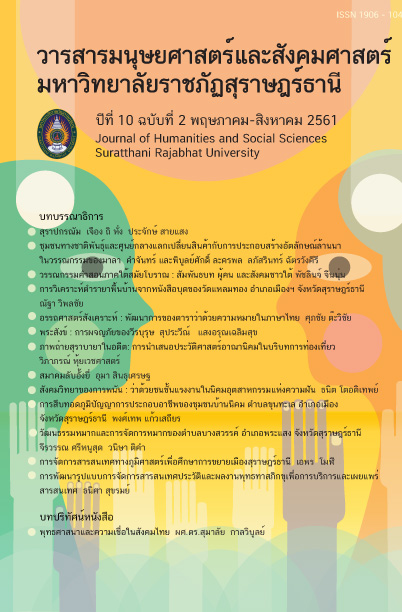The Development of the Textbooks on Meanings in Thai
Main Article Content
Abstract
Abstract
Currently the study of meanings in Thai has gained wide popularity among linguists. This paper intends to analyze the development of the textbooks on meanings in Thai. The data collected for this study were textbooks from the Ayudhaya period up to the present whose contents involved the study of meanings in Thai.
The results show that the development of the textbooks on meanings in Thai can be divided into 2 times: 1) before linguistic influences, which mostly scattered in such textbooks as “Jindamanee”, “Aksornnitt”, “Vipojphijarn”, “Pakeeranumpojanath” and “Upaiyapoj”, most involving only the sense relations and meaning change; and 2) after linguistic influences. The scope of the study of meanings in Thai has been hugely expanded according to the trends of meaning studies in the west. The important western theories of the studies include historical linguistics, structural linguistics, and cognitive linguistics. Most Thai textbooks in this period are usually called “Semantics” and have a high tendency to focus more on meanings which reflected the relationship between language and its thinking system.
Keywords : Textbooks, Development, Thai language, Language Meanings
Article Details
All published manuscripts have been verified by peer-peer professors in the fields of humanities and social sciences. Reprinting of the article must be authorized by the editorial staff.
References
Textbooks. Bangkok : Chulalongkorn University.
Benchawan Suntharanukul. (1980). Analysis of Thai Textbooks. Bangkok :
Ramkhamheang University.
Chatchawadee Saralamba. (2002). “Language and Meaning.” In Introduction
Linguistics. Department of Linguistics, faculty of arts, Thammasat
University.
Chatchawadee Saralamba. (2007). Semantics. Department of Linguistics,
Faculty of Arts Thammasat University.
Department of Fine Arts, Department (1970). Pra Thom Kor Ka, Pra Thom
Ma La Hat Arn, Pa Thom Ma La, Ak Sorn Ni Ti Beap Phim
Nung Sue Thai. Thonburi : Rungwattana.
Fromkin, Victoria, Rodman, Robert and Hyams, Nina. (2003). An
Introduction to Language. Fort Worth : Harcourt Brace
Jovanovich.
Johnson, Mark. (1987). The Body in the Mind : The Bodily Basis of
Meaning, Imagination, and Reason. Chicago : University of
Chicago Press.
King, Brian. (1989). “The Conceptual Structure of Emotional Experience in
Chinese.” Ph.D. Dissertation, Ohio State University.
Kövecses, Zoltán. (2002). Metaphor : A Practical Introduction. Oxford:
Oxford University Press.
Kövecses, Zoltán. (2005). Metaphor in Culture : Universality and
Variation. Cambridge : Cambridge University Press.
Kritsadawan Hongladarom and Teeranoot Chauksuvanit. (2008). Pragmatics.
Bangkok : Academic dissemination project Faculty of Arts,
Chulalongkorn University.
Lakoff, George and Johnson, Mark. (1980, 2003). Metaphors We Live By.
Chicago and London : The University of Chicago Press.
Lakoff, George. (1999). Philosophy in the Flesh. New York : Basic Books.
Lakoff, George. and Johnson, Mark. (1981). Conceptual Metaphor in
Everyday Language. In Mark Johnson (ed.), 286-325, 1981.
Lakoff, George. and Johnson, Mark. (1987). Women, Fire, and Dangerous
Things : What Categories Reveal about the Mind. Chicago : The
University of Chicago Press.
Natthaporn Panpotong. (2012). “Text Book 2201 783 Pragmatic Analysis of
Thai (Revised edition).” Thai Department, Faculty of Arts,
Chulalongkorn University.”
Navavan Bandhumedha. (1970). Language Usage. Bangkok : Women's
Association Higher Education Authority of Thailand.
Navavan Bandhumedha. (1984). Language Usage 2. Bangkok : ah – laan.
Nerlich, Brigitte. (1991). Semantic Theories in Europe 1830 – 1930 : from
Etymology to contextuality. Amsterdam : John Benjamins.
Nittaya Kanchanawan. (2003). Anasysis of Thai Structure. Bangkok :
Ramkhamheang University.
Niyada Lausunthorn. (2009). Development of Thai Textbooks. Bangkok :
Laikham.
Patcharee Palawong. (1999). Introduction of Semantics. Bangkok :
Ramkhamheang University.
Patcharee Palawong. (2001). Introduction to Semantics. Bangkok :
Department of English and Linguistics, Faculty of Humanity,
Ramkhamheang University.
Piansiri Wongwipanon. (1982). “meaning.” In Thai language teaching
materials 3 Unit 7 - 15, 287 - 368. Nonthaburi : Sukhothai
Thammathirat Open University.
Pornpilas Ruangchotwit. (1990). Kaan Tham Phot Cha Na Nu Krom.
[Dictionary] Faculty of Humanity, Chiangmai University.
Pornpilas Ruangchotwit. (1992). Componential Analysis. Faculty of
Humanity, Chiangmai University.
Pornpilas Wongcharuen. (2011). Meaning in Thai Language. Thai Language,
Department of Eastern Languages, Faculty of Humanity, Chiangmai
University.
Praphasri Siha-umphai. (2007). Language culture. Bangkok : Chulalongkorn
University.
Praya Anoomanratchathon. (1972). Philology. Bangkok : Klangwitthaya.
Praya Srisunthornwoharn (Noi Arecharnrayangkoon). (1971). Thai Volume 1
– 3. 3th. Bangkok : Rungruangtham.
Praya Srisunthornwoharn (Noi Arecharnrayangkoon). (1972). Thai Language.
5th. Bangkok : Klangwitthaya.
Praya Srisunthornwoharn (Noi Arecharnrayangkoon). (1978). Wai Phot Pra
Phan Lea Pi Sarn Ka Run. Bangkok : Memorial to the funeral of
Mrs. Thip Niyomhet. Prachachon Press.
Praya Srisunthornwoharn (Noi Arecharnrayangkoon). (1978). Beab Sorn
Nang Sue Thai Khong Praya Sri Sun Thorn Wo Harn (Noi
Arecharnrayangkoon). 4th. Bangkok : Klangwitthaya.
Praya Srisunthornwoharn. (1971). Moonlabotbanphakit Wahanitnikorn
Arksornprayok Sangyokpithan Waipotphicharn Phisarnkarun.
8 th. Bangkok : Krungthon Press.
Royal society. (2007). Coyote. Retrieved July 6, 2017, Web site :
http://www.royin.go.th
Royal society. (2003). Linguistics Terminologies The Royal Institute
Version. Bangkok : Royal society.
Saeed, I. John. (2009). Semantics. Oxford : Blackwell.
Siriporn Panyametheekul. (2007). “Textbook L 314 Study of Meaning.”
Department of Linguistics, Faculty of Humanities, Srinakarinwirot
University.
Sunanta Unchaleenukul. (1997). “Research Report on the Development
of the Thai Language.” Ratchadapisek Foundation.
Chulalongkorn University.
Suphachai Tawichai. (2011). “Textbook 411 219 Semantics.” Department of
Thai Language, Faculty of Arts, Silpakorn University.
Suphachai Tawichai. (2017). “Semantics : Conceptual Analysis of Meaning in
Language” A Handbook for the Development of Learning Skills in
the 21st Century: The Fourth World Wide Project, Department of
Thai Language Faculty of Humanities Kasetsart University.
Suriya Ratanakul. (2001, 2012). Introduction to Semantics. Nakornpathom :
Institute of Language and Research Culture for Rural
Development Mahidol Univer


